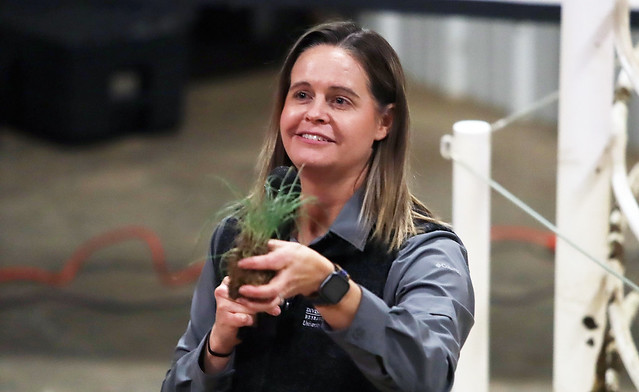Ranchers get full day of production advice at Little Red River Beef Cattle Conference
Wide-ranging program included breeding, conformation and pasture management.
By Mary Hightower
U of A System Division of Agriculture
Feb. 24, 2023
Fast facts
- Haller: More hay samples mean more accuracy
- Cowculator can help producers make better feed decisions
(Newsrooms: With art https://flic.kr/s/aHBqjAt4xv;
Related story: Mitchell: We haven’t reached the bottom yet in U.S. cattle inventories)
(675 words)
HEBER SPRINGS, Ark. — You can’t judge a bale of hay by its cover, but you can use a Cowculator to help make better decisions.
University of Arkansas System Division of Agriculture Cooperative Extension Service agents gave several tips to cattle producers at the Little Red River Beef Cattle Conference on Feb. 17.
Clyde Fenton, Searcy County staff chair, opened the presentations, reviewing protein and energy requirements for cattle. He further broke down feeds in terms of total digestible nutrients, or TDN, which is comprised of total fiber, protein, fats and carbohydrates. Growing calves, lactating and pregnant cows have added protein requirements.
Hay testing
Brian Haller, White County extension staff chair, talked about the importance of hay
testing. As part of the event, he placed three borrowed hay bales outside the venue
and asked participants to score the bales; ranking them in terms of nutrition.
The best-looking bale turn out to be the lowest in nutrient content.
“You can’t tell the nutrient quality of hay just by looking,” Haller said.
When pulling hay samples, Haller said “The more samples you get, the more accurate your test will be.”
Haller recommended pulling 20 to 25 samples from across different lots and cuttings. Download extension’s hay testing fact sheet.
Making decisions
Stone County Extension Staff Chair Tyler Caston, talked about warm vs. cool season
annuals as well as use of Oklahoma State University’s Cowculator to help ranchers make feed decisions for their herd.
Caston also discussed sudangrass, johnsongrass in the ranch operation and cautioned ranchers about the grasses’ ability to accumulate nitrates during drought or after frost which can kill cattle.
“In drought don’t graze for four days after a good rain,” he said. “Be sure to wait a week on sudan family grasses. There’s no way to spray or water or otherwise mitigate Prussic acid in grass. It’s just a waiting game.”
Cattle genetics
Griffin’s wide-ranging presentation covered the importance of conformation in cattle;
how too little or too much pastern angle or sickle hocks could mean additional wear
and tear on hips and other joints.
He also discussed expected progeny differences, or EPD.
“People sometimes find EPDs intimidating,” he said. When Griffin asked how many in the audience used EPDs in their operation, about half the hands went up. EPDs are difference in performance that can be expected in the calves from one animal when compared to calves from another animal or group of animals. Each breed has its own EPD data set, he said.
Griffin encouraged ranchers to use EPDs as a tool to help manage herd quality. Download the extension fact sheet on EPDs.
Weeds
“The most hard-to-control weeds are the most prolific seed producers,” said Amy Heck,
Cleburne County extension staff chair. “Some of these seed producers can be detrimental
to your pasture. The plantain has 36,000 seeds per plant. If you have a few of those
jn your pasture, you’ve got quite a problem.”
Those seeds can travel for miles and can remain in the soil for up to 60 years.
“Weeds can bank their seeds in the soil,” she said. “Those seeds are spread by wind, water, birds, animals, equipment. We spread them as well.”
She said a local extension office can help ranchers find the best means to manage weeds, including the potential for on-farm demonstrations and provide recommendations.
Independence County Extension Staff Chair Michelle Mobley in her presentation meant to help ranchers spend their time and money wisely, cited a unique challenge to weed management is “being a part-timer or a hobbyist” rancher.
“When you work jobs and you can only spray at a certain time and the weather doesn’t cooperate, the weeds don’t get sprayed,” she said.
Scouting is an important tactic. Mobley said the economic threshold for managing weeds “usually when we have 20 percent weeds” in the pasture.
“If you’re not out looking in your fields, you don’t know what weeds you have until it’s too late,” she said.
Download or peruse extension’s Recommended Chemicals for Weed and Brush Control, a must-have for every farm operation.
To learn about extension programs in Arkansas, contact your local Cooperative Extension
Service agent or visit www.uaex.uada.edu. Follow us on Twitter and Instagram at @AR_Extension. To learn more about Division
of Agriculture research, visit the Arkansas Agricultural Experiment Station website: https://aaes.uada.edu/. Follow on Twitter at @ArkAgResearch. To learn more about the Division of Agriculture,
visit https://uada.edu/. Follow us on Twitter at @AgInArk.
About the Division of Agriculture
The University of Arkansas System Division of Agriculture’s mission is to strengthen agriculture, communities, and families by connecting trusted
research to the adoption of best practices. The Division of Agriculture conducts research
and extension work within the nation’s historic land grant education system through the Agricultural Experiment Station
and the Cooperative Extension Service.
The Division of Agriculture is one of 20 entities within the University of Arkansas
System. It has offices in all 75 counties in Arkansas and faculty on five system campuses.
Pursuant to 7 CFR § 15.3, the University of Arkansas System Division of Agriculture
offers all its Extension and Research programs and services (including employment)
without regard to race, color, sex, national origin, religion, age, disability, marital
or veteran status, genetic information, sexual preference, pregnancy or any other
legally protected status, and is an equal opportunity institution.
# # #
Media contact: Mary Hightower
mhightower@uada.edu
@AgInArk
